Tag: Death Valley
January 13, 2012
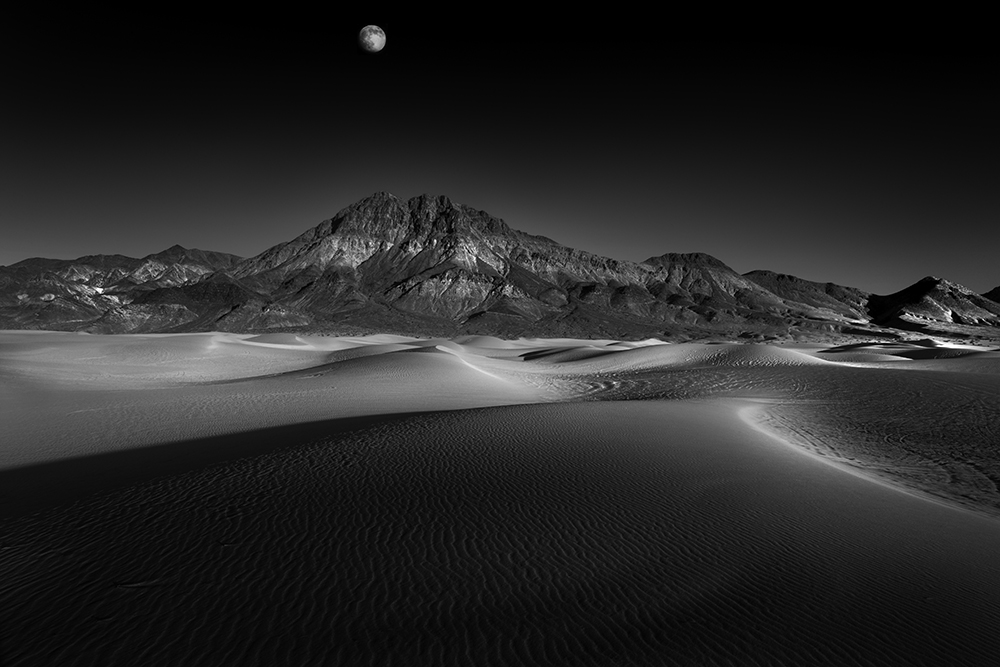
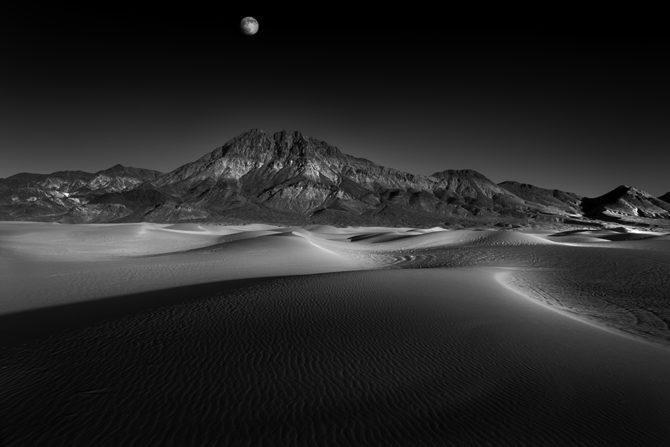
Today is Friday, tomorrow morning I’ll be in the car and driving to Death Valley. I go there every year about this time, alone, to create. I really enjoy this trip for both the location and the solitude. It’s where I recharge my creative batteries by blocking out the rest of the world and focusing on just one thing: seeing.
I’m just going to write my random thoughts as I embark on this trip, and as I’ve been writing three articles for the last two weeks, my mind is a muddle of thoughts. All semi-gelled and semi-fluid at the same time.
Location, does it matter? Theoretically it shouldn’t, I should be able to find a great shot in my bathroom. But the reality is that going somewhere new does seem to help us see anew and fresh. I don’t need a fantastic location like Yosemite which wears all it’s beauty close to the surface, just somewhere where my eyes can see it freshly.
Shooting alone or with others? I never can photograph with others present, I must be alone. When I have others with me I am constantly focused on if I’m inconveniencing them by staying out too long. Plus if there was someone with me I’d have to talk. I don’t want to talk on these trips, I just want to see and think.
Expectations. Sometimes when I go on these trips I have expectations that I must bring something great back or I’ll disappoint others. I need to lose any sense of obligation to others and only seek to please myself. If I come home and I didn’t find anything, then that’s okay. You cannot force creativity, in fact I think that this actually retards the process. Let it be. In truth if I come home with just one decent image, I’ll be as happy as a bird with a french fry!
Photographing where billions have photographed before. Yes, going to a widely photographed location such as Death Valley has its drawbacks, everything has been photographed a BILLION times. That is why I avoid the typically photographed spots or at least if I do go there, I try to photograph them differently. Remember that anyone can stand where Ansel Adams stood, frame the shot the same way and produce a nice shot. But in the end it will only be an weak imitation and is that really what you want to do, imitate others? The key is photographing with your vision, that’s what will make the images uniquely yours.
Isolation. I’ll be isolated for two weeks and I’ll love it. After these trips I always become more appreciative of people, a little friendlier and more centered. City life is grueling and not so good for the soul.
Mexican food. I’ll be stopping at every little hole-in-the-wall Mexican restaurant, looking for that local hidden secret. Mexican food is the best!
What’s important in life? I was recently asked in an interview to describe my perfect day, here is what I said:
With my many years of experience, I’d answer this question much differently than I would have when I was younger! Strangely enough the perfect day may not involve photography at all. Despite how much I love photography, I do not love it more than my family or my life. Photography is not my life, but it is one of those special things that help me to enjoy life.
A perfect day would be spent with my family and new grandson. We would spend the morning walking around the cove, and then we would dive the La Jolla ecological reserve and finish up by picnicking on the grass overlooking the Cove. I’d then slip away and go do some long exposure work while relishing the feel of the warm sun on my face, listening to the sounds of the beach, enjoying the smells and just being grateful that I could enjoy it all. And oh yes, we’d have Mexican for dinner!
Death Valley is such a wonderful place and especially so in the winter; it’s isolated, uncrowded and seeming barren. I say “seemingly” because if you stop, sit and look you will see the truth. It just takes some patience and time to see. But that’s also true life, slowing down and taking the time to look will reveal much.
Goodbye. I hope I’ll be back in a few weeks.
Cole
October 21, 2011
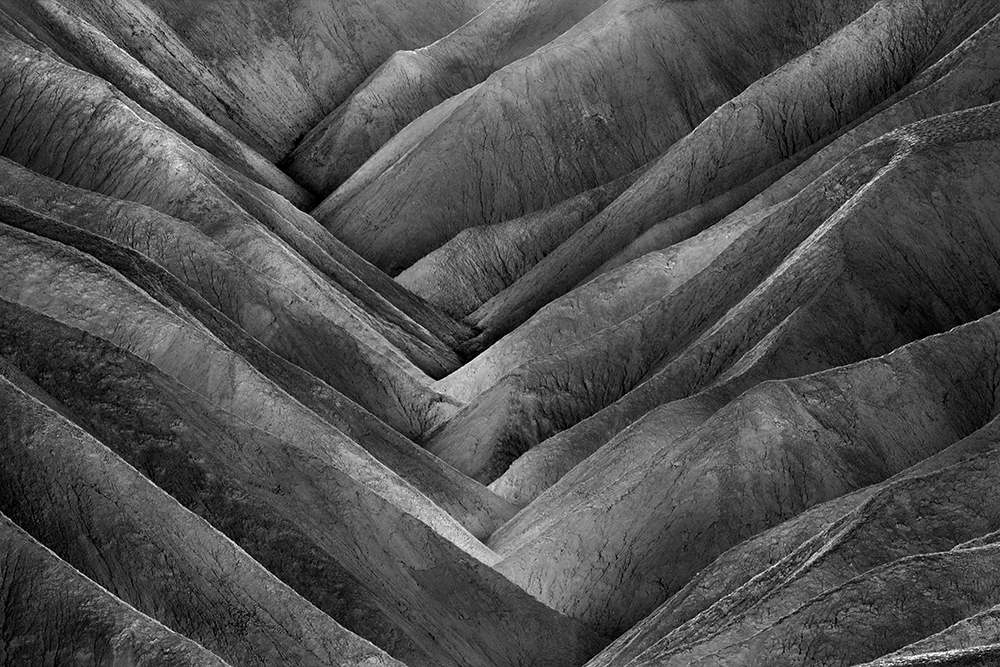
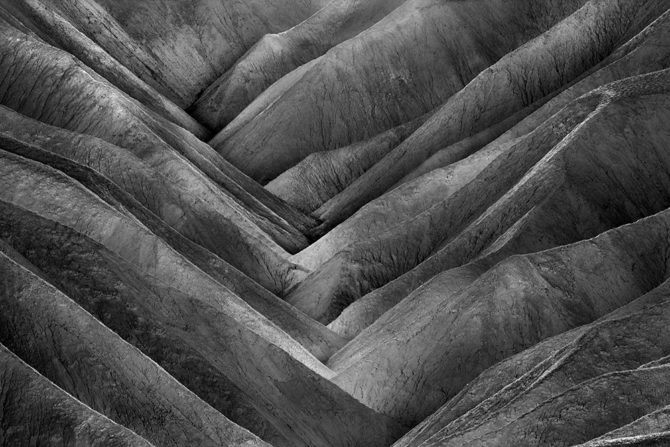
This is “Time No. 2” that I created at Zabriskie Point in Death Valley, perhaps the most photographed spot in the entire park. This image was created just before the sun went down and it’s amazing how Zabriskie Point can look so differently as the light changes from morning, to noon and to late afternoon.
Today I wanted to show a “before and after” so you could see what the original image looked and how your vision can change it. Sometimes vision takes place as you’re shooting and sometimes it occurs when you’re processing the image. And sometimes your vision changes over time and so you go back and change the image repeatedly (you should see how the The Angel Gabriel has evolved over time).
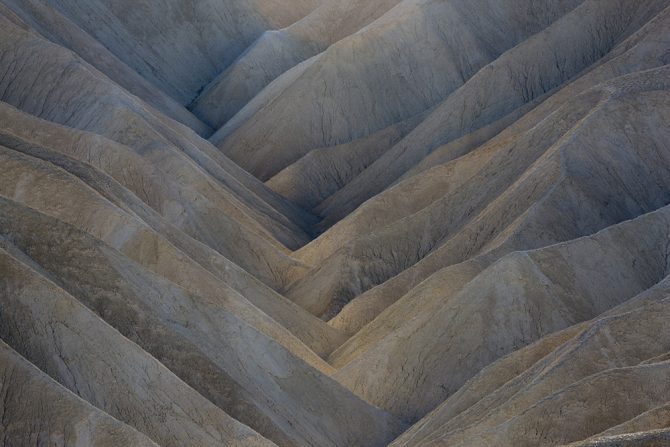
This original image is quite flat and muted, and so to make this a “Cole Thompson” image, I had to improve the contrast and separate the colors. I do this by adjusting the color channels in the black and white conversion tool of Photoshop CS5. By sliding each color’s adjustors in both directions, you can see how it will affect the contrast and separation. With the colors I had in this image, I was able to change the b&w version quite a bit by adjusting the color channels; the Red and Yellow channels brought out highlights, the Blue channels darkened certain parts of the image, and the green had no effect. When adjusting the channels, be careful not to go so far that you introduce unacceptable amounts of noise, particularly in the blue channels.
I then dodge and burn the image with my tablet to further enhance the contrast. In this image I used a very small brush to individually work each piece of the image so that I brought out the striations that separated each set of hills. I particularly paid attention to the ridge tops and brought out the highlighted edges.
One of the most important steps in my conversion process is to use the “Histogram” to check the blacks and white and then to adjust them using “Levels” if necessary (it’s almost always necessary). After you have established a good black and white, you can use “Levels” to adjust the midtones and really change the mood of your image, for my images I generally am pushing the midtones darker.
Once the image looks great on screen, I then use the global contrast adjustment to push the contrast even further so that it will print with the same “pop” that it has on screen. Remember that a monitor uses transmitted light and that always makes things look better than it will on a print. The reason for this is that a print uses reflected light which is quite dull and flat by comparison. By pushing the contrast further than you think you should, it will help ensure the printed piece looks good.
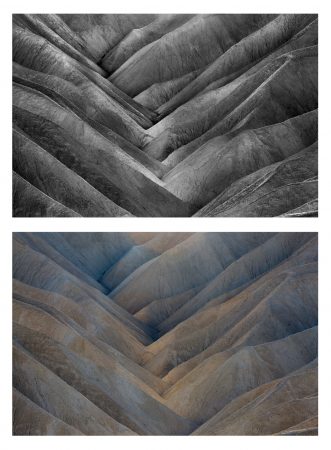
For me, the appeal of this image is it’s simplicity, it’s detailed contrasts and the compressed perspective. Death valley is really a spectacular place, especially in the winter. I go each January and just revel in the timeless solitude.
Cole
P.S. What I don’t like about side by side comparisons is when someone always writes and says “I like the color image better!” I’m just kidding of course, we all have our individual tastes and mine just runs to the black and white.
December 9, 2008


I just returned from a trip to Southern California and Death Valley. I created a few images and had the best luck in Death Valley. I hadn’t been for years and what a treat to travel there in the low season, there were extremely few people and mild 70 degree days. It was a treat!
The image above was taken at Zabrinski Point, perhaps the most photographed location in Death Valley. I’ve seen photographs of the photographers at Zabrinski point and they are packed in like sardines waiting for the sunrise. When I was there, there wasn’t a single soul there, photographer or otherwise.
What impressed me most about Death Valley is how time stands still there. The tentative title of the image above is “Time No. 2”
More images are coming from this great trip, so watch for the newsletter. If you’re not receiving it, you can read past issues or sign up HERE.
Merry Christmas everyone!
Cole
